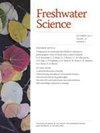Nutrient processing domains: Spatial and temporal patterns of material retention in running waters
IF 1.6
4区 环境科学与生态学
Q3 ECOLOGY
引用次数: 3
Abstract
Reaches are a fundamental unit for lotic biogeochemical characterization, yet a functional classification of nutrient processing at the reach scale is currently lacking. Here, we introduce nutrient processing domains (NPDs) to integrate routing (nutrient delivery) and local (benthic uptake and transformation) processes that dictate longitudinal patterns of lotic biogeochemical function. An NPD is defined as a realm in functional space occupied by reaches that share similar biogeochemical character. Occupation of a given NPD reflects characteristic net material balance (NMB), exchange potential, and availability, associated with changes in solute load, the extent of hydrologic gain or loss, and changes in concentration from the head to the base of a reach, respectively. Using a mass-balance approach, we represent NMB as the effective solute flux (Feff, M L−2 T−1, where M = mass, L = length, and T = time), designating reaches as sources (+Feff) or sinks (−Feff). Discharge change along a reach is measured as the change in hydraulic load (ΔHL, L/T), reflecting the potential for import and export to influence solute loads. Finally, the ratio of downstream-to-upstream concentration (Cdwn:up) represents the net effect that processes have on nutrient availability. Using a 20-y historical record for N and P in the Upper Clark Fork River, Montana, USA, we employed this approach to 3 consecutive reaches covering nearly 90 km of channel length to address spatial and temporal dynamics in NPD behavior in a nutrient-rich, productive river system. For total N and total P, reaches typically occupied compiler or enhancer NPDs, displaying load increases without or with concomitant increases in concentration, respectively. In contrast, reaches were NO3− consumers, acting as sinks for NO3-N during summer and autumn. NO3− load reductions were typically accompanied by striking declines in concentration, despite positive exchange potential (i.e., +ΔHL). Measured Feff magnitudes for NO3− (−1.2 to −60.0 mg N m−2 d−1) were similar to those reported in the literature associated with autotrophic N demand. Individual reaches occupied contrasting NPDs for NO3-N and soluble reactive P by simultaneously serving as a sink for one and a source for the other. Hence, alternating reaches acted as enhancers or consumers, sequentially along the river, reflecting geologic and biological influences with implications for whole river behavior. The NPD approach combines routing influences of material exchange and local biological stream processes to provide a biogeochemical taxonomy for stream reaches with application to theory and practice.营养加工领域:流动水中物质滞留的空间和时间模式
河段是乳液生物地球化学特征的基本单元,但目前缺乏河段尺度的营养处理功能分类。在这里,我们引入了营养加工域(NPD),以整合路径(营养输送)和局部(底栖生物吸收和转化)过程,这些过程决定了乳液生物地球化学功能的纵向模式。NPD被定义为具有相似生物地球化学特征的河段所占据的功能空间领域。给定NPD的占用反映了特征净物质平衡(NMB)、交换潜力和可用性,分别与溶质负荷的变化、水文损益的程度以及从河段顶部到底部的浓度变化有关。使用质量平衡方法,我们将NMB表示为有效溶质通量(Feff,M L−2 T−1,其中M=质量,L=长度,T=时间),将河段指定为源(+Feff)或汇(−Feff)。河段的流量变化被测量为水力负荷的变化(ΔHL,L/T),反映了进出口影响溶质负荷的潜力。最后,下游浓度与上游浓度之比(Cdwn:up)表示工艺对养分有效性的净影响。利用美国蒙大拿州克拉克福克河上游20年的N和P历史记录,我们对覆盖近90公里河道长度的3个连续河段采用了这种方法,以解决营养丰富、多产的河流系统中NPD行为的空间和时间动力学问题。对于总N和总P,达到通常被占用的编译器或增强器NPD,分别显示负载增加而没有或伴随浓度增加。相比之下,河段是NO3消费者,在夏季和秋季充当NO3-N的汇。NO3负荷的减少通常伴随着浓度的显著下降,尽管存在正交换潜力(即+ΔHL)。NO3−(−1.2至−60.0 mg N m−2 d−1)的Feff测量值与文献中报道的自养氮需求量相似。个体通过同时充当NO3-N和可溶性反应性P的汇点和源点,占据了NO3-N的对比NPD。因此,交替河段起到了增强子或消费者的作用,沿着河流顺序排列,反映了地质和生物影响,对整个河流的行为产生了影响。NPD方法结合了物质交换和当地生物流过程的路径影响,为河段提供了一种可应用于理论和实践的生物地球化学分类法。
本文章由计算机程序翻译,如有差异,请以英文原文为准。
求助全文
约1分钟内获得全文
求助全文
来源期刊

Freshwater Science
ECOLOGY-MARINE & FRESHWATER BIOLOGY
CiteScore
4.10
自引率
0.00%
发文量
49
审稿时长
6-12 weeks
期刊介绍:
Freshwater Science (FWS) publishes articles that advance understanding and environmental stewardship of all types of inland aquatic ecosystems (lakes, rivers, streams, reservoirs, subterranean, and estuaries) and ecosystems at the interface between aquatic and terrestrial habitats (wetlands, riparian areas, and floodplains). The journal regularly features papers on a wide range of topics, including physical, chemical, and biological properties of lentic and lotic habitats; ecosystem processes; structure and dynamics of populations, communities, and ecosystems; ecology, systematics, and genetics of freshwater organisms, from bacteria to vertebrates; linkages between freshwater and other ecosystems and between freshwater ecology and other aquatic sciences; bioassessment, conservation, and restoration; environmental management; and new or novel methods for basic or applied research.
 求助内容:
求助内容: 应助结果提醒方式:
应助结果提醒方式:


